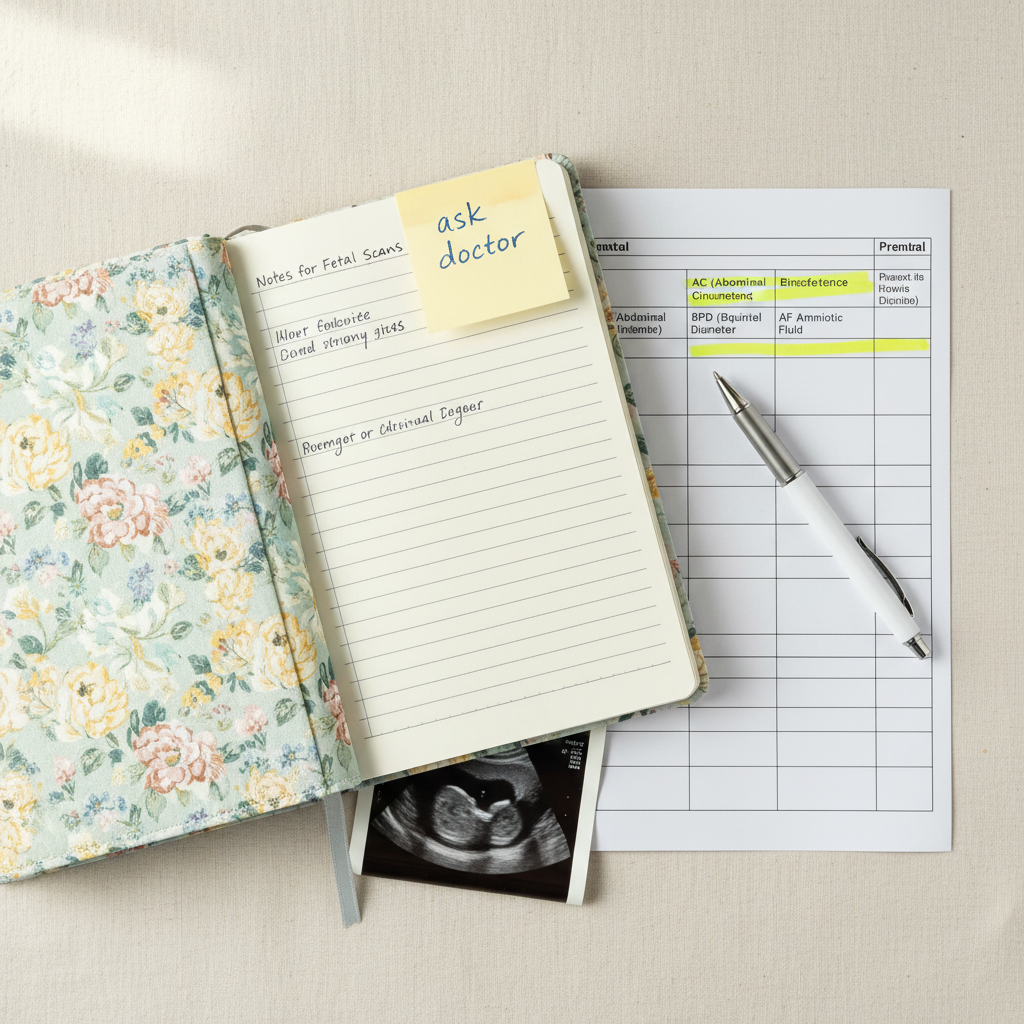
Understanding Medical Terms in Your Prenatal Reports
Medical appointments during pregnancy often come with a flood of unfamiliar terminology that can leave expectant parents feeling confused and overwhelmed. Understanding these medical terms isn’t just about satisfying curiosity—it’s about becoming an active participant in your prenatal care, especially during the second trimester when more detailed monitoring begins.
Key Highlights
Here’s what you’ll learn about decoding medical terminology during pregnancy:
- Common abbreviations like LMP (last menstrual period) and BP (blood pressure) that frequently appear in prenatal charts
- Basic pregnancy terms including gestation, breech, and cephalic positioning
- How to interpret ultrasound measurements that track your baby’s growth
- Important health condition terms that might come up during checkups
- Practical strategies for communicating effectively with your healthcare providers
Understanding Changes: Medical Terminology Basics

Medical terminology can seem like a foreign language during pregnancy, but it becomes less intimidating once you understand the basics. Many terms you’ll encounter during the second trimester follow patterns that make them easier to decode. For example, terms ending in “-gravida” refer to pregnancies (primigravida means first pregnancy), while those ending in “-para” relate to births (primipara means first birth). Learning these patterns helps you piece together meanings even when facing unfamiliar terms.
The abbreviations in your chart tell an important story about your pregnancy journey. LMP (last menstrual period) helps calculate your due date, while BP (blood pressure) and FH (fetal heart) track vital health indicators for you and your baby. Understanding these common shorthand notes empowers you to follow your care more closely and ask informed questions during appointments. Rather than feeling lost in translation, you’ll gain confidence in discussions about your pregnancy progress.
Understanding Changes: Decoding Your Prenatal Reports
Prenatal reports contain valuable information about your pregnancy, but they’re often filled with technical language that can be difficult to understand without guidance. When you receive ultrasound reports during your pregnancy, you’ll likely see measurements like AC (abdominal circumference), BPD (biparietal diameter or head size), and FL (femur length) that help track your baby’s growth. These measurements are compared to growth charts to ensure your baby is developing appropriately for their gestational age.
Your reports may also reference amniotic fluid levels, placental position, and fetal positioning. For instance, cephalic position (head down) is the ideal position for birth, while breech position (bottom down) might require additional monitoring as you approach your due date. Being familiar with these terms helps you participate actively in conversations about your baby’s development and any potential concerns. When reviewing these reports with your healthcare provider, don’t hesitate to ask for clarification on any terms you don’t understand.
Your Body & Baby: Pregnancy Milestones in Medical Terms

The medical terminology used to describe pregnancy milestones helps track the remarkable journey your body and baby are on together. During the 2nd trimester, your healthcare provider will monitor fetal development using specific terms that indicate important stages. For example, “quickening” refers to when you first feel your baby move, typically between 16-25 weeks. Your prenatal visits will also track fundal height, measuring the distance from your pubic bone to the top of your uterus, which should roughly correspond to your weeks of gestation.
Understanding these milestone terms helps you connect clinical information with the physical changes you’re experiencing. While learning about milestones that mark your baby’s growth at 16, 20, and 24 weeks, you’ll discover how medical terminology reflects your baby’s development. For instance, terms like “anatomy scan” (the detailed ultrasound around 20 weeks) have significant meaning for tracking your baby’s structural development. These medical terms serve as important markers in your pregnancy journey.
Your Body & Baby: Health Condition Terminology
Pregnancy introduces a range of potential health conditions that come with their own terminology. Being familiar with these terms helps you better understand any concerns your healthcare provider might discuss. Gestational diabetes mellitus (GDM) and pre-eclampsia are conditions that may develop during pregnancy and require special monitoring. Understanding that elevated glucose levels or blood pressure readings might prompt these discussions helps you prepare mentally for these conversations without unnecessary alarm.
You might also encounter terms related to pregnancy headaches second trimester, which can sometimes be a concern depending on their severity and accompanying symptoms. Healthcare providers differentiate between common tension headaches and those that might indicate blood pressure issues. When discussing symptoms with your doctor, being familiar with the terminology they use helps you provide more precise information about your experience and understand their assessment more clearly. This knowledge transforms potentially stressful discussions into opportunities to track your baby’s health comprehensively.
Healthy Living Tips: Becoming Your Own Medical Translator

Building your medical vocabulary is an ongoing process throughout pregnancy, but there are practical strategies to help you become your own medical translator. Bringing a notebook to appointments allows you to jot down unfamiliar terms that you can research later or ask about before leaving. Don’t hesitate to ask your healthcare provider to explain medical terminology in simpler language—most providers appreciate patients who take an active interest in understanding their care.
Online resources from reputable medical organizations can also help supplement your knowledge between appointments. Understanding how prenatal vitamins support your baby’s development and other aspects of prenatal care becomes easier when you’re familiar with the related terminology. Many patients find it helpful to prepare questions before appointments, particularly about any terms or concepts from previous visits that remained unclear. Remember that becoming fluent in “doctor speak” is a gradual process—even by the 2nd month pregnancy appointments, you’ll notice your comfort with medical terminology growing.
Healthy Living Tips: Building Confidence at Appointments
Effective communication with your healthcare team is essential for a positive pregnancy experience. When you understand medical terminology, you can express your concerns more precisely and comprehend recommendations more fully. If English isn’t your first language or medical terms feel particularly challenging, consider bringing a support person to appointments or requesting an interpreter. Healthcare providers want you to fully understand your care, so don’t hesitate to use these resources when needed.
Building confidence at appointments also means recognizing your role as an advocate for your health and your baby’s wellbeing. Asking questions isn’t a sign of ignorance—it demonstrates engagement and responsibility. Some patients find it helpful to repeat information back to their provider in their own words to confirm understanding. This approach ensures you’re correctly interpreting important details about your pregnancy progress and any recommendations for care. Remember that understanding medical terminology is an important tool that helps you participate fully in decisions about your pregnancy journey.
Embracing Your Pregnancy Knowledge Journey
Understanding medical terminology transforms your prenatal appointments from potentially confusing experiences to empowering opportunities for learning about your changing body and growing baby. As you progress through your pregnancy, particularly during the second trimester when monitoring becomes more detailed, this knowledge helps you become a more confident and engaged participant in your care. Remember that every pregnancy is unique, and becoming familiar with these terms helps you better understand your individual experience and communicate effectively with your healthcare team.
